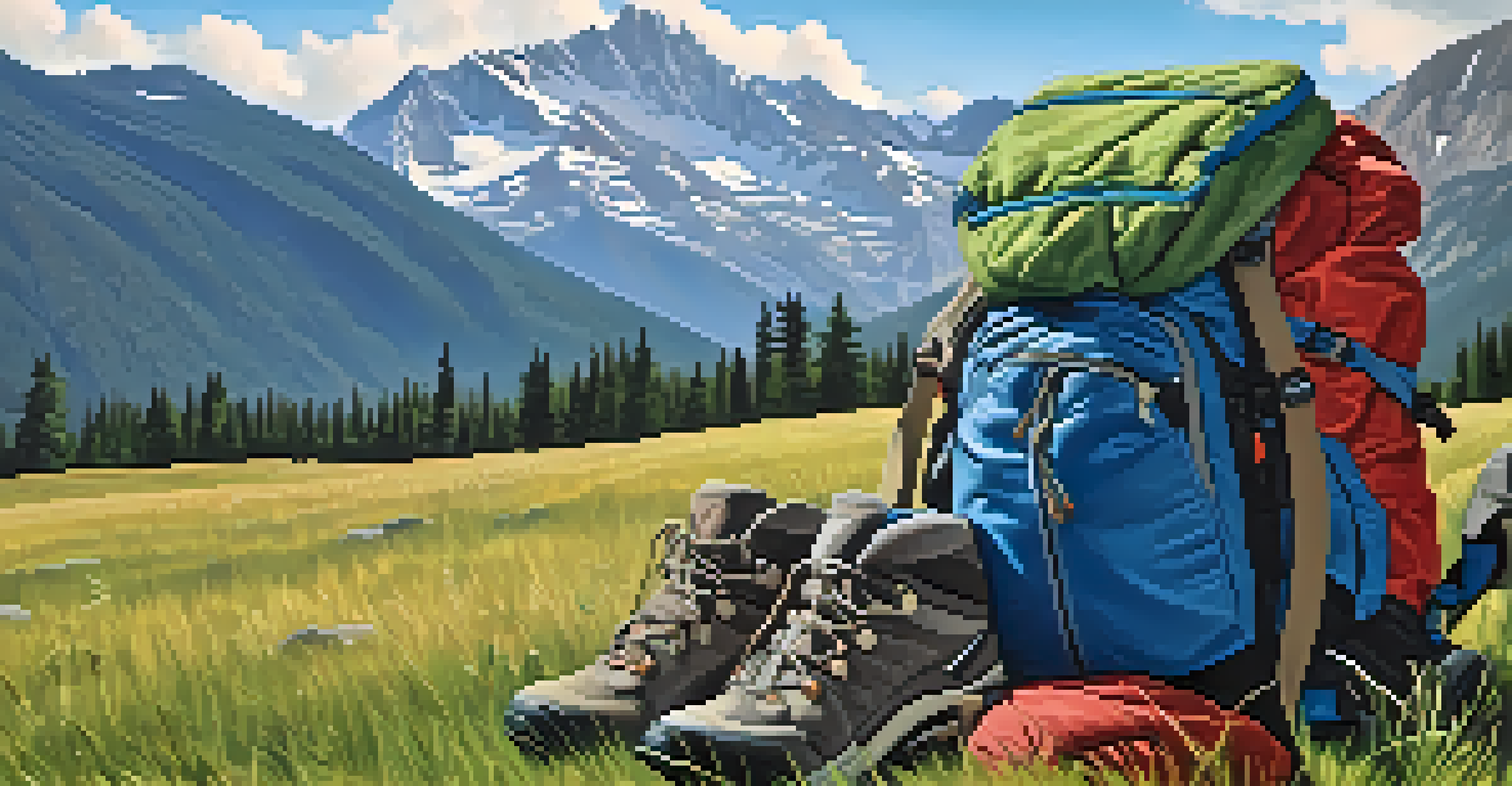Essential Gear for Exploring National Parks: A Guide

The Importance of Proper Footwear for Hiking Adventures
When it comes to exploring national parks, your choice of footwear is crucial. Comfortable, sturdy hiking boots or shoes can make all the difference during long treks on rugged terrain. They provide the necessary support and traction to keep you safe, whether you're navigating rocky trails or muddy paths.
There is no such thing as bad weather, only inappropriate clothing.
Consider waterproof options if you anticipate wet conditions. This will help keep your feet dry and comfortable, allowing you to focus on the breathtaking scenery rather than blisters. Remember, a good pair of hiking shoes can be your best friend on an outdoor adventure.
Take the time to break in your shoes before hitting the trails. Walking around town or doing short hikes can help prevent discomfort during your national park excursions. Trust me, your feet will thank you!
Backpacks: Choosing the Right Size and Features
Selecting the right backpack is essential for carrying your gear comfortably. A good rule of thumb is to choose a pack that suits the length of your hike. For shorter day hikes, a daypack with a capacity of 20-30 liters is usually sufficient, while multi-day trips may require larger backpacks that can hold 50 liters or more.

Look for features like padded straps, a hip belt, and adjustable torso lengths for maximum comfort. Ventilation systems can also be a game-changer, especially in warmer weather, as they help keep your back cool and dry. Don’t forget about pockets; having easy access to snacks and maps can enhance your hiking experience.
Choose the Right Footwear
Comfortable and sturdy footwear is essential for safety and enjoyment during hiking adventures.
Ultimately, the right backpack should feel like an extension of your body. It should distribute weight evenly to avoid strain as you navigate the trails, allowing you to enjoy your adventure without discomfort.
Essential Clothing: Dressing for Varying Weather Conditions
When exploring national parks, dressing in layers is a smart strategy. Weather conditions can change rapidly, so wearing moisture-wicking base layers, insulating mid-layers, and a waterproof outer layer will keep you comfortable in different climates. For instance, if the sun shines one moment and rain falls the next, you’ll be prepared!
The mountains are calling, and I must go.
Don’t forget about your accessories, either. A wide-brimmed hat can shield you from the sun, while gloves and a beanie are essential for chilly evenings. Additionally, choose quick-drying fabrics that will keep you comfortable and dry throughout your adventures.
Investing in high-quality clothing designed for outdoor activities can make a significant difference in your overall experience. You'll feel more comfortable and confident tackling those challenging trails when you're dressed appropriately.
Hydration: Staying Hydrated on Your Outdoor Adventures
Staying hydrated is crucial when exploring the great outdoors. Dehydration can sneak up on you, especially during strenuous hikes. Carry a reusable water bottle or a hydration reservoir that allows you to sip on the go, ensuring you keep your energy levels up.
A good rule of thumb is to drink about half a liter of water for every hour of hiking, but listen to your body and adjust as needed. Adding electrolyte tablets or powders to your water can help replenish lost minerals, especially on hot days or after intense activities.
Hydration is Key Outdoors
Staying hydrated is crucial for maintaining energy levels and preventing dehydration on hikes.
Plan your hikes around water sources if possible. Knowing where you can refill your water supply will give you peace of mind and help you stay hydrated throughout your adventure.
Navigation Tools: Maps and GPS for Safe Exploration
Having reliable navigation tools is essential for any national park adventure. While smartphones are convenient, they can lose signal in remote areas, so carrying a physical map and compass is a wise backup. Familiarize yourself with the park's layout and trail maps before setting out.
Many parks also offer visitor centers where you can pick up maps and get advice from rangers. They can provide insights into trail conditions and must-see sights, enhancing your overall experience. Consider downloading offline maps or trail apps that work without a signal for added convenience.
Remember, getting lost can turn an enjoyable hike into a stressful situation. By being prepared with navigation tools, you'll have the confidence to explore new trails while staying safe.
Safety Gear: Essential Items for Outdoor Preparedness
Safety should always be a priority during outdoor adventures. Carrying a basic first-aid kit can help you handle minor injuries like cuts, scrapes, or insect bites. Be sure to include items like antiseptic wipes, adhesive bandages, and pain relievers to address common issues on the trail.
Additionally, consider packing a multi-tool or knife for various tasks, from preparing food to making quick repairs. A whistle and a flashlight are also important safety items to include, as they can be invaluable in emergencies.
Respect Wildlife in Parks
Observing wildlife from a safe distance helps protect both animals and their natural habitats.
Lastly, don’t forget about personal safety. Share your itinerary with someone who isn't going on the trip, and have a plan in place in case you encounter unexpected situations. Being prepared helps ensure your adventure remains enjoyable.
Wildlife Safety: Respecting Nature and Its Inhabitants
Encountering wildlife is one of the most exciting aspects of visiting national parks, but it's essential to respect the animals and their habitats. Always maintain a safe distance from wildlife and avoid feeding them, as human food can harm animals and disrupt their natural behavior. Observing from afar is the best approach.
Familiarize yourself with the types of wildlife you may encounter and learn how to react if you come across them. For example, knowing how to behave if you see a bear or a snake can keep you safe. Many parks provide guidelines on wildlife safety, so take the time to read up before you go.

Ultimately, being a responsible visitor helps preserve the beauty of national parks for future generations. By practicing good wildlife etiquette, you contribute to the conservation of these incredible places and their inhabitants.
Tech Gadgets: Enhancing Your National Park Experience
In today’s tech-savvy world, several gadgets can enhance your national park experience. Portable chargers are a must-have, especially if you rely on your phone for navigation or photography. Avoid the frustration of a dead battery by bringing extra power wherever you go.
Consider carrying a lightweight camera or binoculars to capture breathtaking landscapes and observe wildlife up close. These devices can help you appreciate the beauty of nature in a whole new way. Many parks also offer guided apps that provide information about trails and points of interest, enriching your visit.
While technology can enhance your experience, remember to disconnect occasionally and soak in the beauty around you. Balancing tech with the natural world allows you to enjoy the best of both!